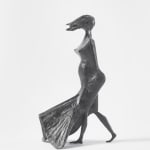Lynn Chadwick British, 1914-2003
Maquette VI High Wind (C22), 1984
Bronze
32 x 19 x 16 cm
12 5/8 x 7 1/2 x 6 1/4 in
12 5/8 x 7 1/2 x 6 1/4 in
Edition 8 of 9
Further images
This wonderful maquette relates to one of Lynn Chadwick's most iconic large late period works 'High Wind', 1984 depicting a young woman being blown across the landscape with her skirt...
This wonderful maquette relates to one of Lynn Chadwick's most iconic large late period works 'High Wind', 1984 depicting a young woman being blown across the landscape with her skirt and hair streaming out in front of her.
Movement was always a key consideration for Chadwick in his figures and beasts and can be traced right back to his early kinetic mobiles that he first made for trade stands in the 1950’s. In his sculpture, Chadwick used structured cloaks, wings and stairs as mechanisms to give his often armless figures movement.
In the High Wind series Chadwick reversed the usual direction of his cloaks to great effect and it is one of the only times we see Chadwick give his figures hair. Here Chadwick uses the figures hair to cover her face continuing his belief that expressionless figures were more powerful saying: ‘No expression is an expression...body language has more power in conveying mood and character than facial features which can be limiting.’
In this beautiful tabletop-sized version Maquette VI High Wind shows a glimpse of Chadwick’s humour which is often overlooked having been associated with the ‘Geometry of Fear’ artists - a term coined by Herbert Read for the 1952 Venice Biennale. In the 1970’s Lynn Chadwick was invited to experiment in casting in silver by Danish silversmith Karl Gustav Hansen along with Barbara Hepworth, Kenneth Armitage and Henry Moore. Of all the artists Chadwick was most drawn to silver’s unique ability to throw back light where bronze would absorb it and this led to a series of small, intimate silver sculptures of which Chadwick also chose to cast a maquette of High Wind.
Movement was always a key consideration for Chadwick in his figures and beasts and can be traced right back to his early kinetic mobiles that he first made for trade stands in the 1950’s. In his sculpture, Chadwick used structured cloaks, wings and stairs as mechanisms to give his often armless figures movement.
In the High Wind series Chadwick reversed the usual direction of his cloaks to great effect and it is one of the only times we see Chadwick give his figures hair. Here Chadwick uses the figures hair to cover her face continuing his belief that expressionless figures were more powerful saying: ‘No expression is an expression...body language has more power in conveying mood and character than facial features which can be limiting.’
In this beautiful tabletop-sized version Maquette VI High Wind shows a glimpse of Chadwick’s humour which is often overlooked having been associated with the ‘Geometry of Fear’ artists - a term coined by Herbert Read for the 1952 Venice Biennale. In the 1970’s Lynn Chadwick was invited to experiment in casting in silver by Danish silversmith Karl Gustav Hansen along with Barbara Hepworth, Kenneth Armitage and Henry Moore. Of all the artists Chadwick was most drawn to silver’s unique ability to throw back light where bronze would absorb it and this led to a series of small, intimate silver sculptures of which Chadwick also chose to cast a maquette of High Wind.
Provenance
From the artist’s estateJoin our mailing list
* denotes required fields
We will process the personal data you have supplied in accordance with our privacy policy (available on request). You can unsubscribe or change your preferences at any time by clicking the link in our emails.









